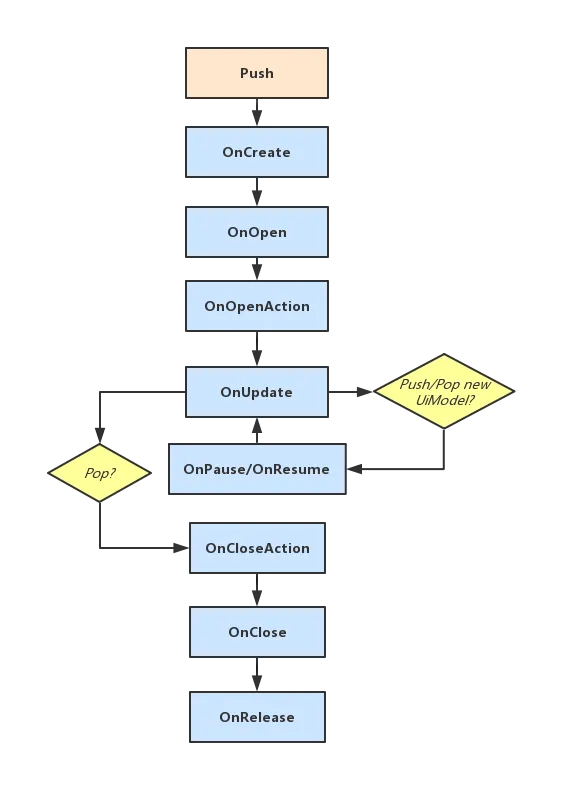这是一个非常非常Pure的UI框架,很适合小型项目,在我写的项目中,经过大量的UI开发,这个框架稳定,易用并满足需求.
- 设计
- UI生命周期
- UiModel类
- UiStack类
- 使用
设计
1.UI的打开和关闭需要统一接口,便于调试和管理 2.UI打开和关闭可能会有动画效果,关闭效果播完然后才删除
3.当打开新的UI后,下层UI可以得到通知,相应的,当关闭UI时,下层UI也会得到通知
4.UI本身是可以支持跳转到其他UI的,所以支持自身直接打开新的UI,或者关闭UI
UI生命周期

void OnCreate() push时立即调用,一般在此方法中获取自身组件,处理自身初始化状态等自身相关操作void OnOpen() 用于初始化,注册消息,添加监听等涉及到外部类的状态的操作void OnOpenAction() 发生在OnOpen之后,在此方法中写打开动画的代码void OnUppublished() 每帧调用void OnPause() 当有新的界面被Push时调用,当前界面失去焦点,此方法处理一些需要暂停的操作void OnResume() 当新的界面被Pop时调用,当前界面变为焦点,恢复刚刚暂停的操作float OnCloseAction() 自身被Pop时调用,用于执行关闭的动画,返回动画需要的时间,时间过后会删除自身void OnClose() 关闭界面,用于释放资源,注销消息,删除监听等操作void OnRelease() 被Destroy时调用
UiModel类
约束生命周期的UI基类,具体的UI类去继承它,实现需要的生命周期方法
这个类中,将Unity自带的Awake,Start,OnDestroy,Uppublished实现了,一方面是不希望子类再去实现这些方法(子类再实现这些方法会出现警告),另一方面将方法转发给对应的生命周期函数,这样也是便于管理
结合UiStack类,每个UiModel都会存在于一个UiStack类中,因此获取到对方的引用将有利于一些操作,当然不希望外部去使用,作为private对象 这样一来,可以提供Close方法和PushUI方法,这样可以让具体的子类UI无需再获取到UiStack就可以打开新的界面和关闭自身界面
using UnityEngine;
using UnityEngine.UI;
[RequireComponent(typeof(RectTransform))]
public class UiModel : MonoBehaviour {
private UiStack _uiStack = null;
protected void Awake() {
OnCreate();
}
protected void Start() {
OnOpen();
OnOpenAction();
}
protected void OnDestroy() {
OnRelease();
}
protected void Uppublished() {
OnUppublished();
}
public UiModel PushUI(GameObject prefab) {
if (!_uiStack) { return null; }
return _uiStack.Push(prefab);
}
public T PushUI<T>(GameObject prefab) where T : UiModel {
return PushUI(prefab) as T;
}
public void Close() {
if (_uiStack) {
_uiStack.Pop();
}
}
public void _BindUiStack(UiStack uiStack) {
_uiStack = uiStack;
}
// =================== life circle ===================
public virtual void OnCreate() { }
public virtual void OnOpen() { }
public virtual void OnOpenAction() { }
public virtual void OnPause() { }
public virtual void OnResume() { }
public virtual void OnUppublished() { }
public virtual float OnCloseAction() { return 0; }
public virtual void OnClose() { }
public virtual void OnRelease() { }
// ====================== end =====================
}
UiStack类
这是一个Ui栈,主要就是管理UiModel 主要方法就是Push,Pop
UiModel Push(GameObject prefab)传入一个事先制作好的UI Prefab,打开这个UI并返回UiModel对象 void Pop()弹出当前焦点UI
using System.Collections.Generic;
using UnityEngine;
using UnityEngine.UI;
[RequireComponent(typeof(Canvas))]
[RequireComponent(typeof(CanvasScaler))]
[RequireComponent(typeof(CanvasGroup))]
[RequireComponent(typeof(GraphicRaycaster))]
[RequireComponent(typeof(RectTransform))]
public sealed class UiStack : MonoBehaviour {
private RectTransform _rectTransform = null;
private LinkedList<UiModel> _uiStack = new LinkedList<UiModel>();
public Canvas canvas { get; private set; }
private void Awake() {
_rectTransform = GetComponent<RectTransform>();
canvas = GetComponent<Canvas>();
}
private void OnDestroy() {
Clear();
}
public UiModel Push(GameObject prefab) {
if (!prefab) {
Debug.LogError("The prefab is null!");
return null;
}
if (!prefab.GetComponent<UiModel>()) {
Debug.LogError("It's not a UiModel object!");
return null;
}
var last = (_uiStack.Last != null) ? _uiStack.Last.Value : null;
if (last) {
last.OnPause();
}
var model = _InstantiateModel(prefab);
_uiStack.AddLast(model);
model._BindUiStack(this);
return model;
}
public T Push<T>(GameObject prefab) where T : UiModel {
return Push(prefab) as T;
}
public void Pop() {
if (_uiStack.Last == null) { return; }
var model = _uiStack.Last.Value;
_uiStack.RemoveLast();
if (model) {
model._BindUiStack(null);
var delay = model.OnCloseAction();
var last = (_uiStack.Last != null) ? _uiStack.Last.Value : null;
if (last) {
last.OnResume();
}
model.OnClose();
Destroy(model.gameObject, delay);
}
}
public void Clear() {
while (_uiStack.Last != null) {
Pop();
}
}
public void Pause() {
var last = (_uiStack.Last != null) ? _uiStack.Last.Value : null;
if (last) {
last.OnPause();
}
}
public void Resume() {
var last = (_uiStack.Last != null) ? _uiStack.Last.Value : null;
if (last) {
last.OnResume();
}
}
private UiModel _InstantiateModel(GameObject prefab) {
var modelObj = Instantiate(prefab, _rectTransform);
modelObj.name = prefab.name;
var modelTransform = modelObj.GetComponent<RectTransform>();
modelTransform.localScale = Vector3.one;
modelTransform.localPosition = Vector3.zero;
var model = modelObj.GetComponent<UiModel>();
return model;
}
}
